Physical Address
304 North Cardinal St.
Dorchester Center, MA 02124
A thorough understanding of the complex anatomy is crucial for successful treatment of extensor tendon injuries.
Injuries are classified into nine anatomic zones. Treatment strategies vary considerably according to the location of the lesion, ranging from splinting to tendon grafting.
Minimal variations in tendon length may result in considerable alteration in range of motion.
As in flexor tendon injuries, postoperative care is an essential part of the treatment concept.
Closed ruptures of the extensor tendon at the level of the distal interphalangeal (DIP) and proximal interphalangeal (PIP) joints are typically treated conservatively.
Lacerations at the level of the metacarpophalangeal (MCP) joint (zone V) are not infrequently caused by human bites and are prone to infection unless thoroughly debrided.
Ruptures of the sagittal bands may result in subluxation of the extensor tendon at the level of the MCP joint.
The swan-neck deformity is characterized by DIP joint flexion and PIP joint hyperextension. It can be caused by an untreated mallet injury or palmar plate laxity.
The boutonnière deformity is characterized by hyperextension of the DIP joint and PIP joint flexion. It can be caused by rupture of the central slip of the extensor tendon or palmar subluxation of the lateral bands.
Complex injuries to the dorsum of the hand can involve skin, tendon, and bone. Adequate debridement is of paramount importance. Before reconstructing tendons, fractures must be stabilized and soft-tissue coverage must be provided.
Operative procedures for extensor tendon injuries are ideally performed utilizing the WALANT (wide-awake local anesthesia no tourniquet) technique.
Relative motion splinting is a recent concept to facilitate and improve postoperative care of extensor tendon injuries.
![]() Access video content for this chapter online at Elsevier eBooks+
Access video content for this chapter online at Elsevier eBooks+
Injuries to the extensor tendons are frequently underestimated. Several reasons might contribute to this phenomenon, including easy access to the tendons due to the thin soft-tissue envelope, their extrasynovial nature, and limited retraction. However, in contrast to common belief, injuries to the extensor tendon apparatus are often more difficult to treat than those of flexor tendons. First of all, a thorough understanding of the complex interactions between the long extensor tendons and the intrinsic muscles of the hand is necessary to achieve good postoperative results. Second, the extensor apparatus consists of superficial, thin structures that are very close to the underlying bones, which makes them prone to develop severe adhesions. Moreover, their excursion amplitude is limited, so that even subtle lengthening or shortening will result in severe restrictions of range of motion. Postoperative regimens vary considerably in respect to the exact location of the lesion and have to be selected carefully.
However, not only the tendon itself but also the surrounding soft tissues have to be taken into consideration when establishing a treatment plan. Extensor tendons are easily exposed on the dorsum of the fingers and hand even after minor trauma due to the thin tissue envelope. Additional procedures are frequently necessary. Shortcomings in adequate soft-tissue coverage will inevitably result in poor overall results, even if the tendons themselves were addressed properly.
The history of tendon surgery reaches back to about AD 200. Galen (130–201) mistook the tendons for nerves and suggested in his Ars Parva that no sutures should be placed within the tendons in order not to cause pain and convulsion. The error was not corrected until the tenth century, when Avicenna of Boukhara (980–1037), in Persia, advocated surgical suturing of tendons. However, this new concept did not reach the West until much later – Galen's dogma was not refuted until the eighteenth century. The basic structure of the extensor tendon mechanism was illustrated by Albinus in 1734. The next step forward was the concept of tendon transplantation, which was introduced in the late nineteenth century. In the beginning of the twentieth century extensive clinical and experimental research was conducted, especially in Germany. Lexer published the results of 10 flexor tendon grafts in 1912. During the first half of the twentieth century, Bunnell developed basic principles of flexor tendon surgery which were published in his masterly book Surgery of the Hand in 1944. Fowler and Landsmeer advanced the concept of the balanced forces and dynamics between the flexor and extensor apparatus in the 1940s. During the 1960s operating techniques were introduced that are still in use today.
The anatomy of the extensor mechanism is complex, and some functional details are still subject to discussion. However, in order to be able to provide the best possible treatment in a given pathologic situation, fundamental knowledge about the functional anatomy of this complex system is critical.
The extensor mechanism consists of extrinsic muscles, which are located on the forearm (extensor digitorum, extensor indicis, extensor digiti minimi [EDM]), intrinsic muscles, which are located at the level of the metacarpals (interosseous and lumbrical muscles), and fibrous structures.
All extrinsic tendons pass through the six compartments of the extensor retinaculum on the back of the wrist ( Fig. 10.1 ). The first compartment is attached to the outer rim of the radius and contains the tendons of the abductor pollicis longus (APL) and extensor pollicis brevis (EPB) muscles. In 34% of patients the compartment is further divided by an additional septum, which has implications for the etiology and treatment of de Quervain's disease. The extensor carpi radialis longus (ECRL) and extensor carpi radialis brevis (ECRB) tendons run through the second compartment, which is bordered by Lister's tubercle on the ulnar side. The third compartment crosses the wrist in a diagonal fashion above the second compartment, while Lister's tubercle acts as a pivot point for the extensor pollicis longus (EPL) tendon. While passing through the compartment, the tendon is quite vulnerable to ruptures, e.g., in fractures of the distal radius. The fourth compartment contains both the extensor digitorum (ED) and extensor indicis (EI) tendons. The EDM and extensor carpi ulnaris (ECU) tendons run through the fifth and sixth extensor compartments, respectively. The ECU not only functions as an extensor for the wrist, but is also part of the triangular fibrocartilage complex (TFCC) and thus a major stabilizer for the distal radioulnar joint.
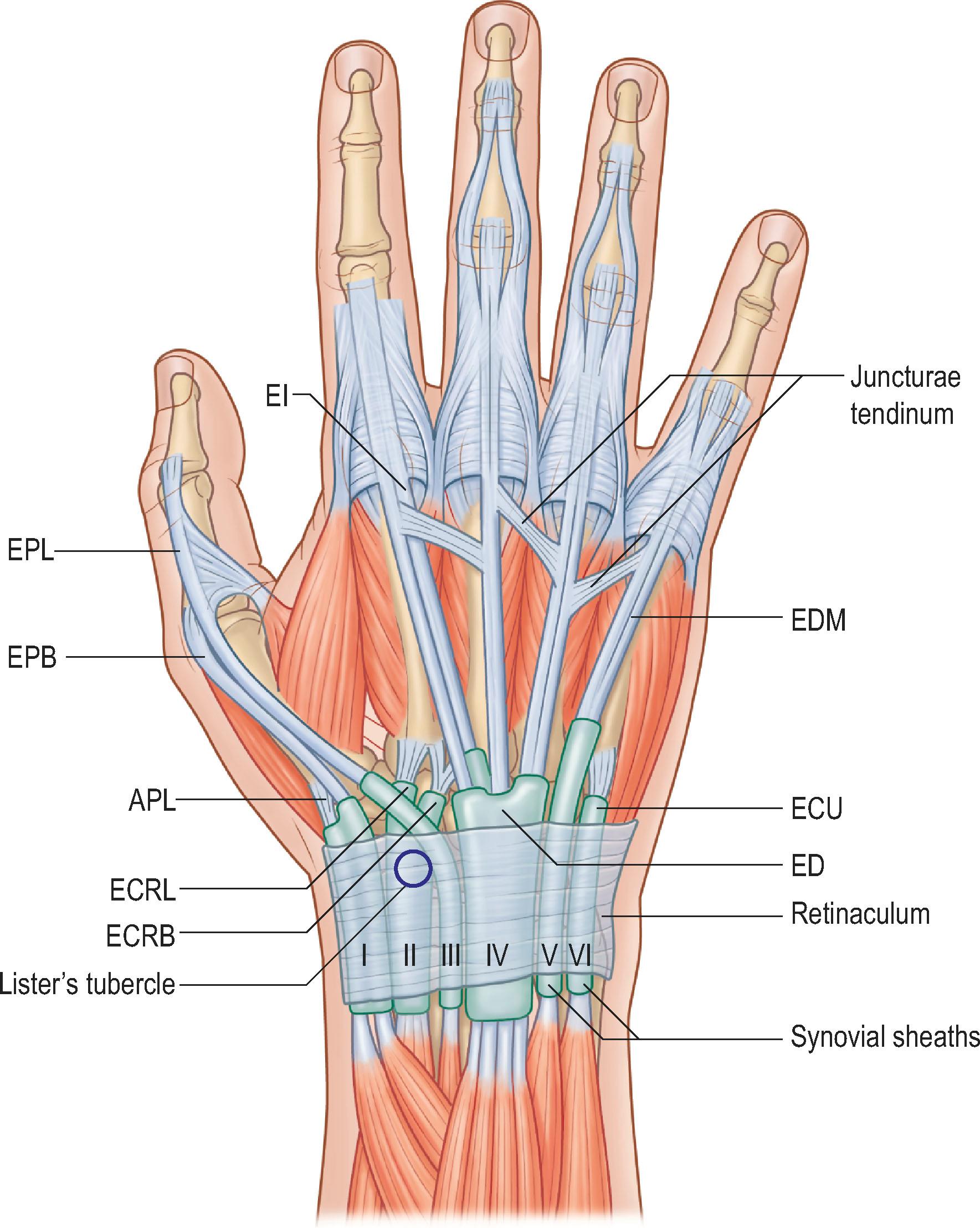
The two extensor proprii tendons of the index and the little finger are located on the ulnar sides of the corresponding communis tendons and allow for individual movements of the peripheral fingers. On the dorsum of the hand, the ED tendons are interconnected by the juncturae tendinum which facilitate combined extension of the fingers. Lacerations of the extensor tendons which are located proximal to the juncturae may be masked by the function of these bands. The patterns of the intertendinous connections are highly variable and have been classified into three types: filamentous, fibrous, and tendinous bands. At the level of the proximal phalanges, the extensor tendons split up into three parts: the central band and two lateral bands ( Fig. 10.2 ). These merge with the intrinsic extensor system to form the complex extensor apparatus of the digits.
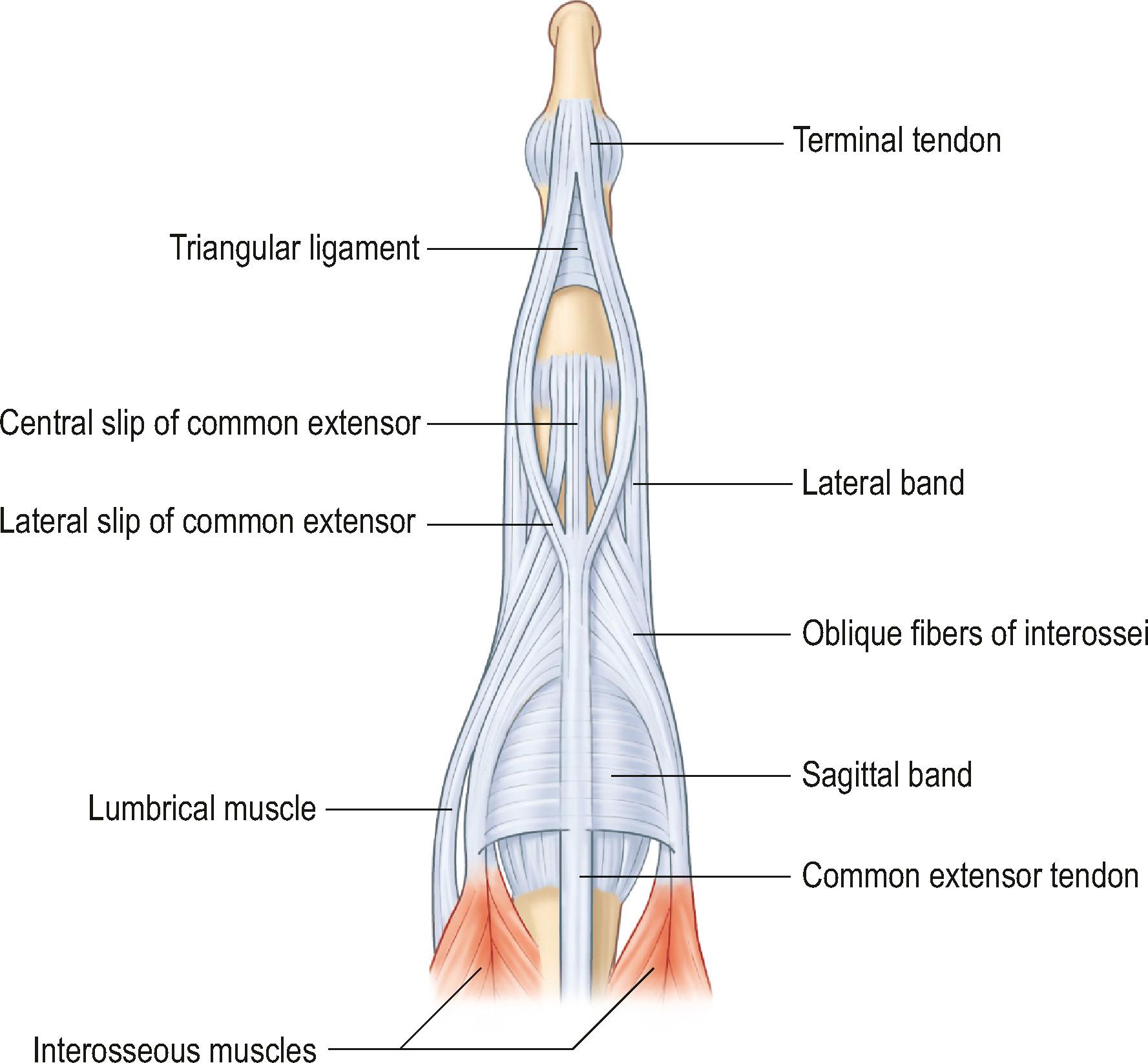
The extrinsic extensor tendons themselves have three insertion sites on the phalanges. Proximally, the tendon is fixed at the level of the metacarpal heads to the palmar plate by the sagittal bands. This attachment centers the tendon of the metacarpophalangeal (MCP) joint and prevents hyperextension. The most important insertion is located at the base of the middle phalanx. Distally, the terminal tendon is attached to the distal phalanx. In addition to these three sites, there is a variable degree of attachment of the tendon to the proximal phalanx.
The intrinsic muscular system of the hand consists of seven interosseous and four lumbrical muscles. The three palmar interosseous muscles arise from the medial sides of the second, fourth, and fifth metacarpal bones and join the extensor apparatus of the digits at the level of the proximal phalanx after crossing palmar to the axis of the MCP joint. The four dorsal interosseous muscles originate with two heads each from the adjacent sides of the five metacarpal bones. The first two interosseous muscles approach the index and middle finger from the radial side; the third and fourth approach the middle and ring finger from the ulnar side. They have insertions at the proximal phalanges and the interosseous hood of the extensor apparatus before joining the lateral bands.
The lumbrical muscles are considered some of the most variable muscles of the human body, while the degree of variation increases from the radial to ulnar muscles. In general, they arise from the radial sides of the flexor digitorum profundus tendons at the level of the metacarpals and join the extensor apparatus from the radial side.
With this arrangement, all four digits have three intrinsic muscles contributing to the extensor apparatus, with the missing ulnar interosseous muscle for the little finger being equivalent to the abductor digiti minimi muscle ( Fig. 10.3 ). The thumb also has three short muscles that join the extensor apparatus: the flexor pollicis brevis (FPB) and abductor pollicis brevis (APB) muscles on the radial side and the adductor pollicis (ADP) muscle on the ulnar side.
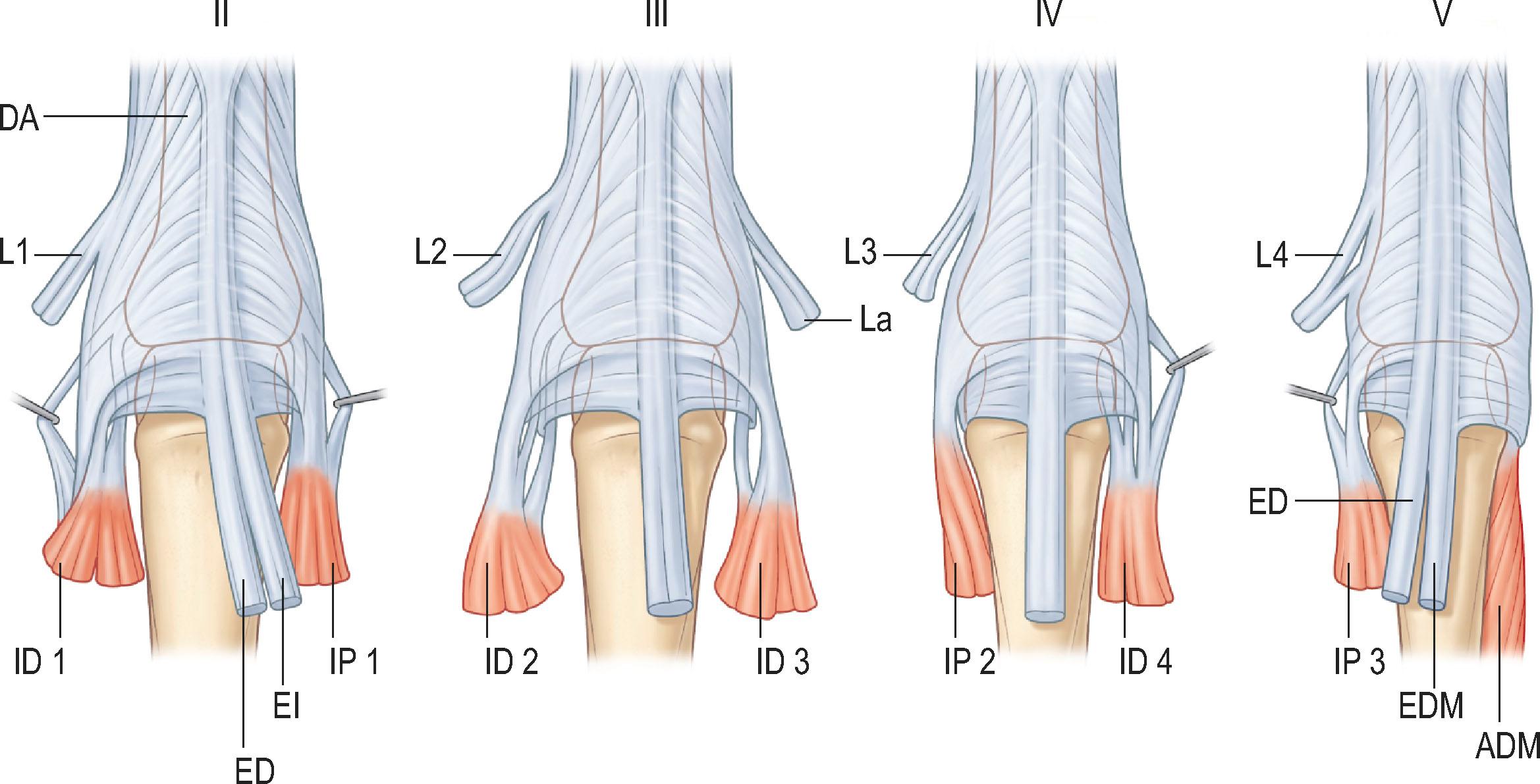
The movement of the fingers is a highly complex mechanism. It is dependent upon a delicate equilibrium between the extrinsic extensor and flexor muscles and the intrinsic muscles. Biomechanically, the finger can be compared to a multiarticular chain comprised of the three phalangeal bones ( Fig. 10.4 ). Landsmeer was able to show that at least three muscles are necessary to control two joints in such a multiarticular chain. For the proximal phalanx, these are the extrinsic extensor and flexor muscles and the diagonal intrinsic system (lumbrical and interosseous muscles). In the middle phalanx there is no diagonal muscle system; instead the third component is made up of the oblique retinacular ligament (Landsmeer's ligament) which has its origin at the flexor pulley and inserts distally into the extensor apparatus. Both of these diagonal systems run palmar to the joint axis proximally and dorsal to the joint axis distally. They play a crucial role in the coordination of extension and flexion movements of the fingers by linking the extrinsic flexor and extensor muscles.
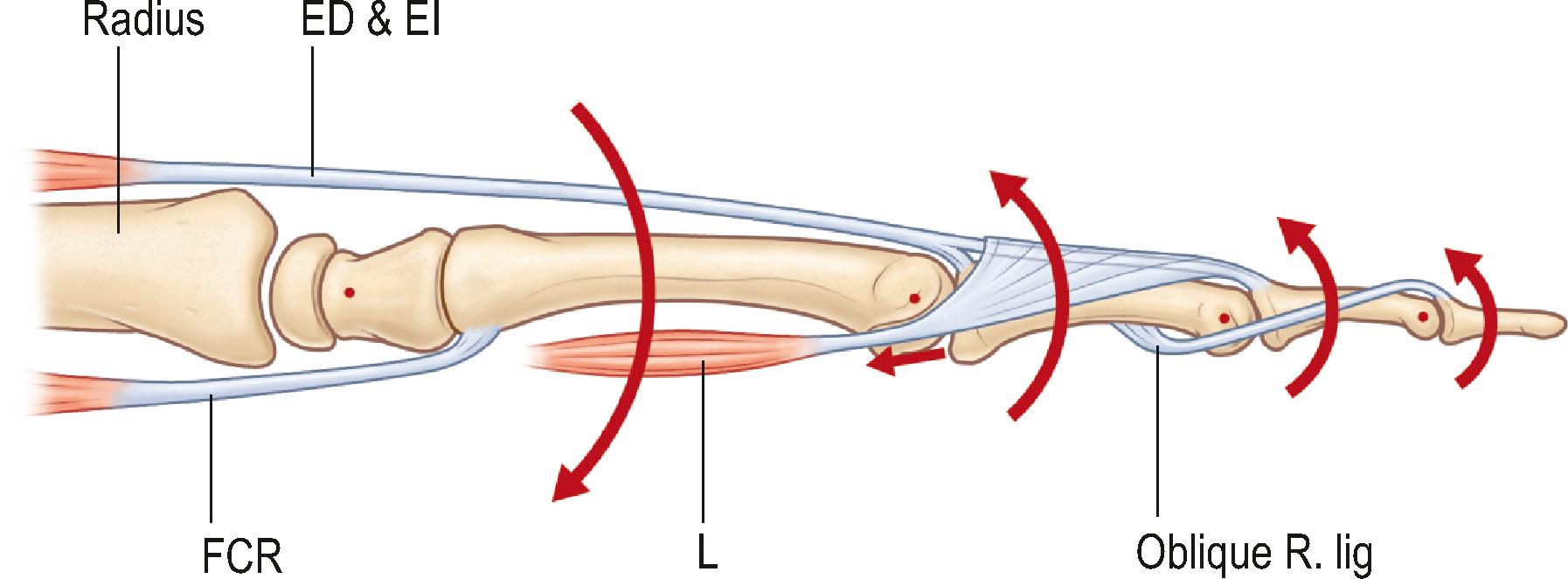
It is generally believed that the intrinsic muscles of the hand act as flexors at the MCP joints and extensors at the interphalangeal joints. However, this is not always true for the interosseous muscles. They approach the extensor apparatus at a much smaller angle (less steep) than the lumbrical muscles. Due to this little anatomical difference, the function of the interosseous muscles is highly dependent on the position of the interosseous hood and therefore as well of the position of the MCP joint. When the MCP joints are in extension, the interosseous muscles cover the articular space and the oblique fibers of the interossei are put into tension, which translates into extension of the interphalangeal joints. However, when the MCP joints are in flexion, the interosseous muscles slide distally on the proximal phalanx. During contraction of the muscles, the interosseous hood is pulled towards the hand and the flexion movement of the MCP joint is enforced. In this position, the interossei lose the extensor function on the distal joints.
The lumbricals join the extrinsic tendon at a much greater angle than the interossei and are therefore not depending in their function on MCP joint position. They act as extensors at the proximal and DIP joint in both extension and flexion of the MCP joint.
It has been shown biomechanically that both the extrinsic flexor and extensor muscles have a component that acts as an extensor on the proximal phalanx. Under physiologic conditions this force is counteracted by the intrinsic muscles. Paralysis of these muscles (as in ulnar nerve palsy) therefore results in hyperextension of the MCP joints. Without intrinsic muscle function the long extensors exhaust their potential at the level of the proximal phalanx. Anatomical studies have demonstrated that isolated contraction of the extrinsic extensors results in hyperextended, clawlike position of the MCP joints, but not complete finger extension. For complete extension of the interphalangeal joints intrinsic muscle function is therefore mandatory.
The MCP joint is extended by the extrinsic extensor tendon. However, there have been debates about how tendon force is transmitted to the joint. The variable direct attachment of the tendon to the proximal phalanx has been shown to have no significant contribution to MCP joint extension. It has been postulated that instead the fibrous connections of the extensor tendon to the flexor sheath are the primary transmitters for extension of the joint.
Extension of the PIP joint is mediated by the central slip of the extensor tendon. However, as stated above, intrinsic muscle function is necessary in order to enable the extrinsic extensor tendon to act on the PIP joint. At the level of the PIP joint, the extensor tendon is centered by the transverse retinacular ligaments. Harris and Rutledge have stressed the importance of the correct position and balance between the central slip and the lateral bands in order to maintain normal PIP extension.
Until the late 1940s, extension of the DIP joint was thought only to be mediated by the terminal part of the extensor mechanism. In 1949 Landsmeer defined the function of the oblique retinacular ligament, which had been unclear since its identification in the 1800s. He described the extension of the DIP joint as a combination of the terminal lateral bands and a tenodesis effect mediated by these ligaments. Later these findings were questioned. However, dissection of the ligament results in lack of extension of the DIP joint.
The diagnosis of extensor tendon injuries is often evident. However, partial lesions can be missed if the remaining tendon is strong enough to create some extension force. As a general rule, open lesions should therefore be surgically explored to identify the extent of the injury and prevent secondary ruptures. The function of the ED tendon should be assessed by extension of the MCP joint of the affected digit against resistance.
To test the integrity of the central slip, the Elson test can be used. To perform this test, the finger to be examined is placed over the edge of a table in 90° flexion of the PIP joint. The examiner pushes the middle phalanx down and asks the patient to extend the finger. Any extension force in the PIP joint is transmitted by an intact central slip. The lack of extension therefore indicates rupture. At the same time, an intact central slip will tether the lateral bands and counteract extension of the DIP joint. Strong extension of the DIP therefore indicates injury to the central slip.
Always obtain a focused history, including the exact mechanism of injury. Expect concomitant osseous involvement in crush injuries. Long-term outcomes should be kept in mind and communicated with the patient when formulating a treatment plan.
When performing an Elson test, strong extension in the PIP and weak extension of the DIP while holding the PIP joint in flexion indicates an intact central slip, while injury to central slip will result in weak extension at the PIP joint and strong extension in the DIP joint.
Intrinsic muscle function may obscure complete lacerations of the ED tendons by extension of the PIP and DIP joints. Always check extension of the MCP joints to rule out ED injuries.
The EPB tendon inserts into the extensor tendon apparatus of the thumb at varying levels and may be able to extend the IP joint of the thumb. If there is a questionable rupture of the EPL tendon, it should therefore not be tested by extension of the IP joint. Instead, the patient should be asked to lift the thumb off the table, which will be impossible without an intact EPL tendon ( Fig. 10.5 ).
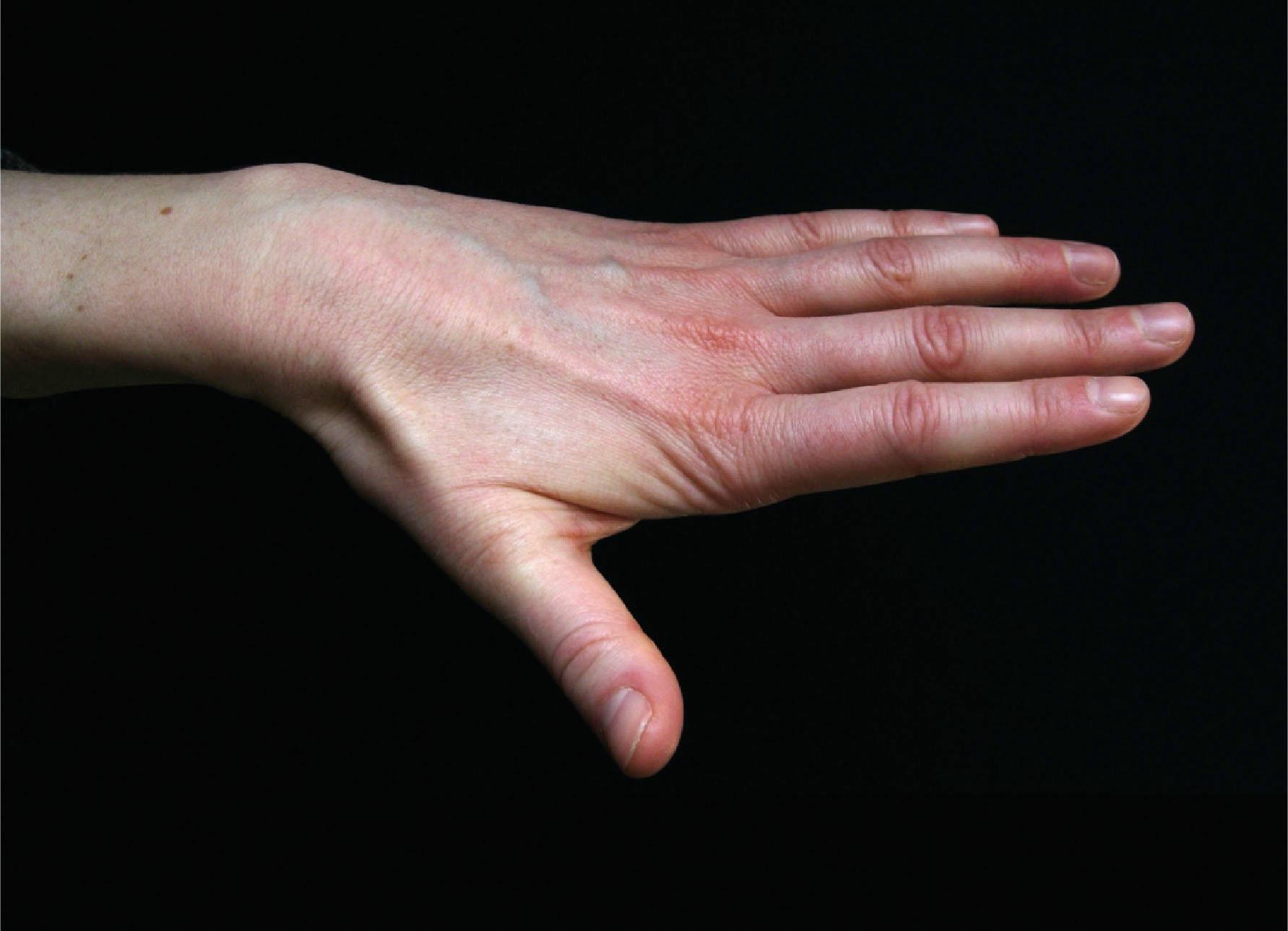
Kleinert and Verdan proposed a system to classify lesions of the extensor tendon apparatus into eight zones according to the level of the lesion. Doyle has added a ninth zone by dividing the forearm into the distal (zone 8) and proximal (zone 9) forearm. This classification is presented in Fig. 10.6 .
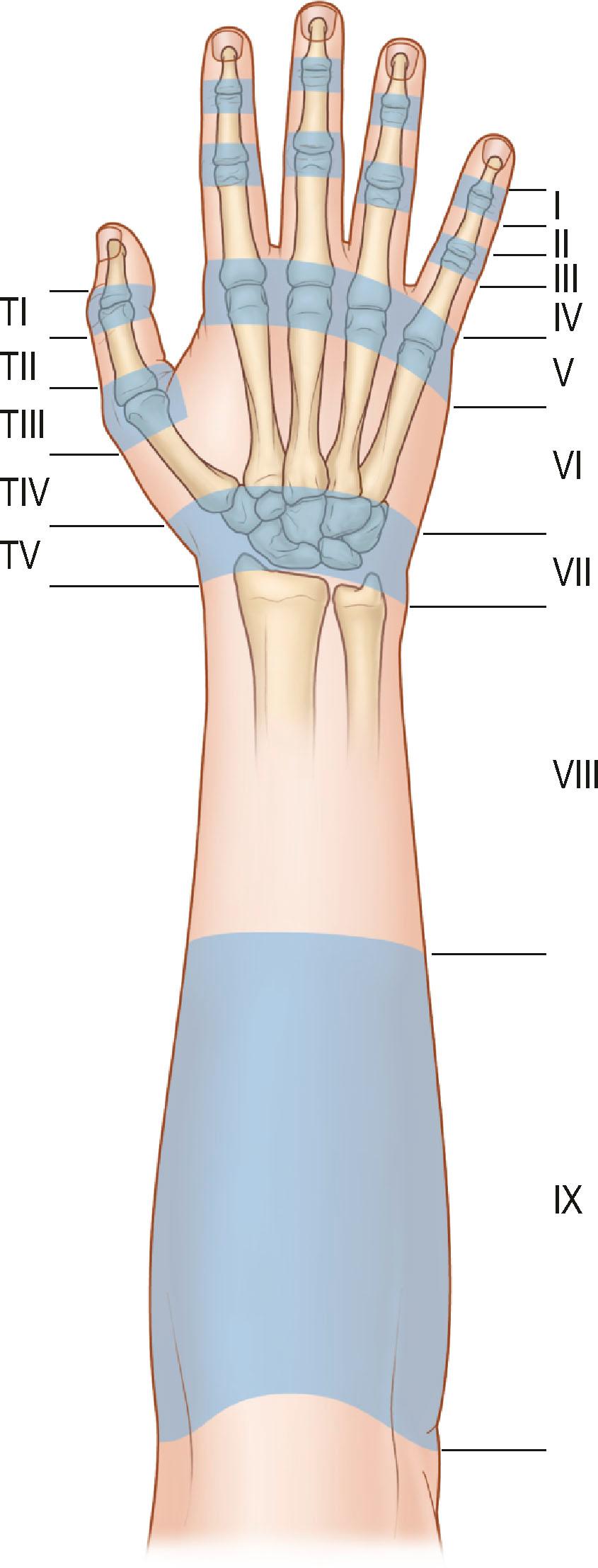
The repair of simple lacerations of the extensor tendon can be safely performed in the emergency room. However, as the lesions are generally underestimated and require sufficient exposure of the tendon, a thorough knowledge of the surgical anatomy and treatment protocols is mandatory. Lacerations proximal to zone VI should be treated in the operating room. The use of loupe magnification should be considered. The patient should be aware that, despite the often short duration of operations, postoperative treatment protocols can be complicated and may last for several months.
Wide-awake or WALANT surgery is a concept that is becoming increasingly popular. In this approach, procedures are performed with no sedation and no tourniquet with the use of tumescent lidocaine and epinephrine (WALANT: wide-awake, local anesthesia, no tourniquet). This technique has been proven to be safe and cost-effective. Most importantly, however, with the patient able to move the fingers during the operation, the surgeon can verify the success of tenolysis or tendon repair procedures immediately. Not only tendon repairs and tenolyses, but also tendon transfers can be most effectively performed in this approach.
The size of the extensor tendon varies considerably during its course from the distal forearm to its terminal insertion at the distal phalanx. While the tendon is round and thick proximally, it becomes thin and flat more distally. Suturing techniques therefore have to be adapted specifically to the location of the lesion. Whatever technique is chosen, it should provide the best stability with the least shortening possible.
In zones II to IV, extensor tendons are thin and flat and, thus, less amenable to suture techniques involving multiple core sutures. For lacerations in theses areas, epitendinous suture techniques have demonstrated favorable results. In zones VI and proximally, the extensor tendon resembles a flexor tendon and as such can be repaired with a core suture and an epitendinous running suture. Commonly used suture strengths include 3-0 and 4-0 for core sutures and 5-0 for epitendinous sutures. For neither flexor nor extensor tendons is there any scientific evidence for an advantage of using resorbable or non-resorbable suture materials. Fig. 10.7 gives an overview of common types of core suture. In order to achieve maximum core suture strength, locking stitches should be preferred over grasping stitches in order to prevent suture pull-out and reduce gapping. However, grasping suture techniques have a higher tensile strength and less gap formation in extensor tendon repair than mattress or figure-of-eight stitches. For flexor tendons, it has been shown that at least four core strands should be applied in order to enable early active motion and the same is probably true for extensor tendon repair.
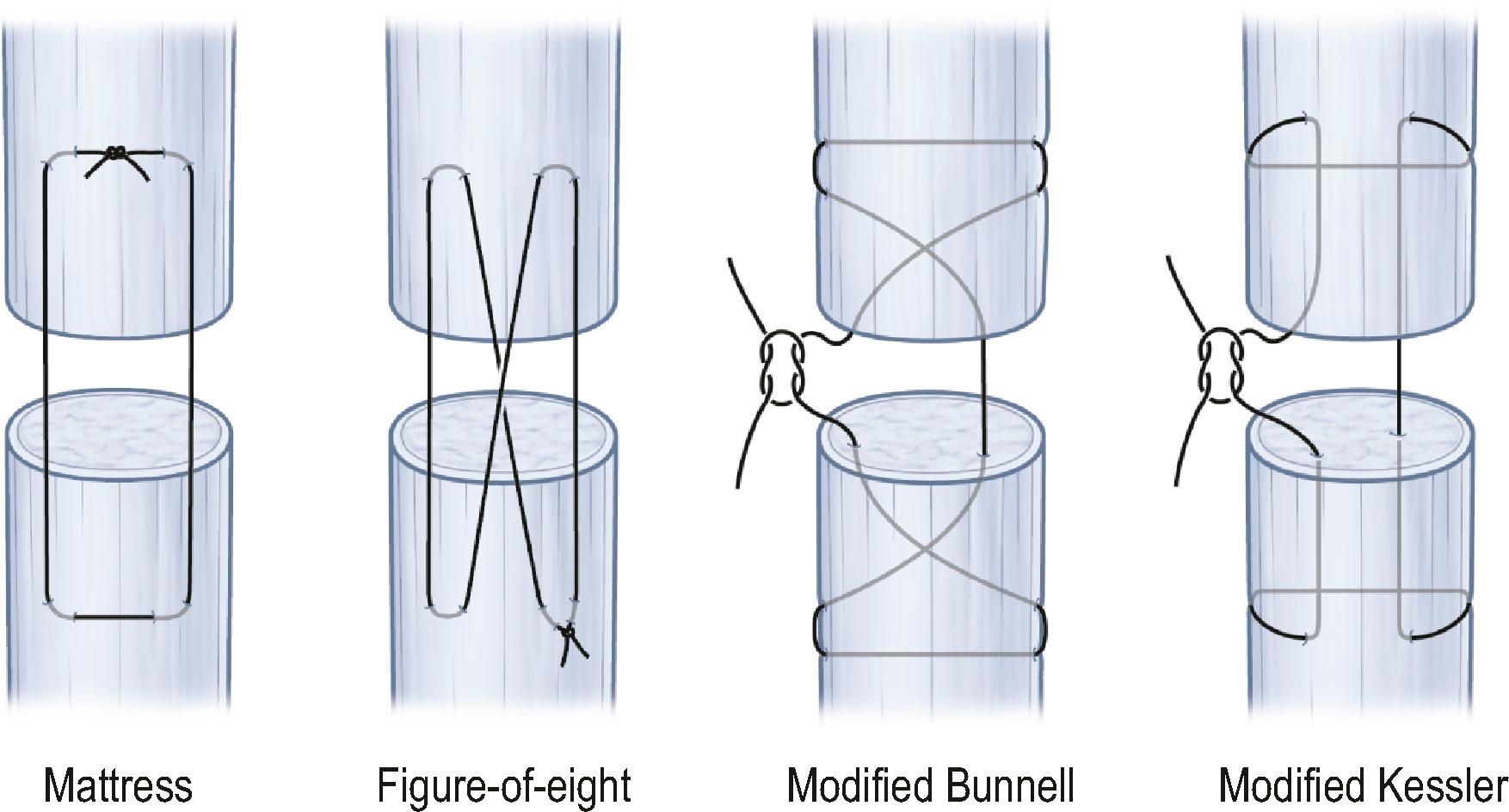
In the more distal zones of injury, locking or grasping core stitches become increasingly difficult due to flattening of the tendon. Newport et al . report that grasping stitches in zone IV injuries are strong enough to enable postoperative early active motion. More recently, Chung et al . have demonstrated that a single cross-stitch may even be superior to multiple cross-stitches in a modified Becker repair of the extensor tendon in zone IV. Simple running stitches should be avoided due to the low pull-out strength in favor of more complex locking suture techniques.
Always check the stability of the sutured tendon intraoperatively by gentle movements of the finger. If possible, use locking core stitches in preference to other techniques. Soft-tissue coverage can be very thin in fingers, so patients may be able to visualize dyed suture material through the skin. This should be avoided.
Become a Clinical Tree membership for Full access and enjoy Unlimited articles
If you are a member. Log in here